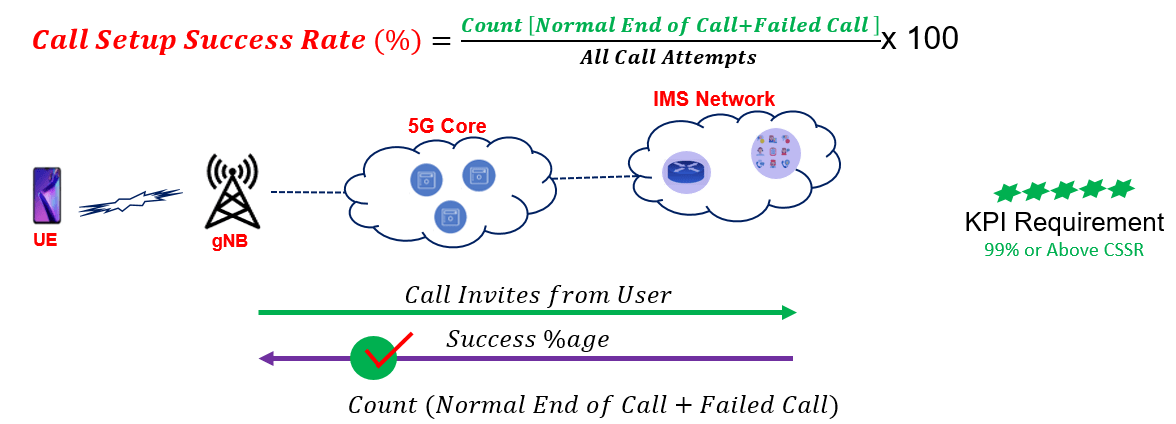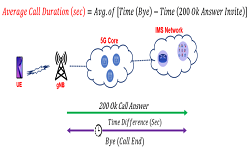VoNR KPI for Control Plane – Key Performance Indicator
VONR KPI
To make a Voice Call in 5G Network, it requires 5G RAN, 5G Core and IMS network and the feature is known as Voice over New Radio (VoNR). In this post, we will discuss about important Key Performance Indicator – VONR KPIs for 5G VoNR.
Pointers for Key Performance Indicators – KPI
- By definition, a KPI is a quantifiable measure used to evaluate and demonstrates, how effectively a telecom network is achieving key technology objectives, service availability and performance, call failures and congestion
- A service provider should designing a proper KPI Framework to meet the Business and Customer Expectations
- The benchmarking for KPIs can be done by keeping Own track of Quality of Service and Customer satisfaction and comparing them to your competitors
- KPIs should give a clear understanding of the current state of your network performance.
VONR KPIs Classification
At high level, the VoNR KPIs can be classified for Control Plane and User Plane. These KPIs further can be classified based on the network elements involved for VoNR Call, Like RAN KPIs, 5G Core KPIs and IMS KPIs.


- VoNR Registration Success Ratio [VoNR RSR] (%): VoNR RSR an accessibility KPI and also known as as Registration Success Rate. This KPI used to depict the probability of UE successfully registering to IMS Network,
- If RSR is degraded, Customers will not be able to use VoNR services due failures in registration
- RSR is calculated as % of SIP Registration Request getting successful
- Once Registration is successful, The IMS network will reply back with 200 OK Message back to UE
- RSR is measured in % age and a healthy network shall have RSR equal or better than 99%
Here is actual Call flow where request goes all the way from UE to P-CSCF to IMS Core & 200 OK Response is tagged as successful


- Call Setup Success Rate [CSSR] – MO & MT (%): CSSR tells you how easily users are able to make or receive VoNR calls on 5G Network . CSSR is Call Setup Success Rate . It can be calculated separately for Outgoing & Incoming (MO/MT) Calls. The CSSR indicates the probability of successful calls initiated or received by the user .
- CSSR KPI is categorized under family of Integrity and retainability KPIs
- Calls failed due to Network issues will be treated as failure and will degrade CSSR
- It is measured in % and recommend value for a healthy network is above 99%
- With Low CSSR, Customers will not be able to use make or Received VoLTE Calls
- Outgoing or MO Call CSSR is calculated as % Calls of able to use network without any problem .
- The calls failed due to user behavior such Busy, not reachable etc. are counted in Normal Call ending or success.

- Call Setup Time [Sec]: Another critical VoNR KPI in 5G SA Network is CST or Call Setup Time . CST is overall length of time required to establish a call between users . CST is Time between the start of the call and the moment the phone of the called party starts ringing, in simple words CST is considered as the time required for call to pass thru a network and reaches B Party User .
- CST is calculated as Difference between SIP Ringing Time to SIP Invite Time
- Call setup time is measured in Seconds and a health network should have CST is Less than 2.5s
- A high CST will lead to delays & silence period before Ring, which will degrade the user experience
- CST KPI is categorized under family of Integrity and retainability KPIs

- Average Call Duration (Sec): Average Call Duration (ACD) also know as Mean Holding Time (MHT) is the average length of an answered call made over a network. ACD is a control plane KPI but provides very important information about user plane. E.g. if Average Call Duration have reduced in a network, it means that calls are being answered but there is some issue with User Plane. Low ACD shows either calls are getting mute or Its One Way Speech or Voice Quality is very bad which leading to users forced to disconnect the call much earlier.




